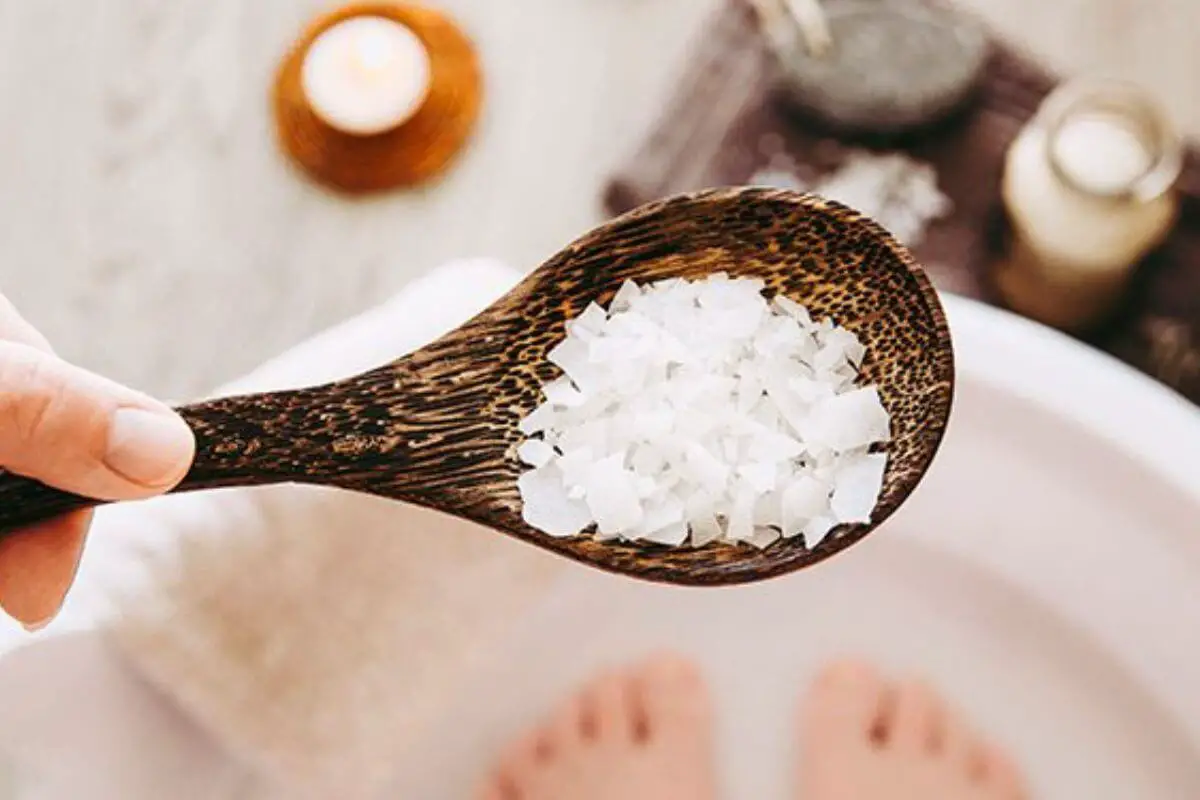Whether you’re an athlete, a fitness enthusiast, or someone who occasionally overexerts themselves physically, muscle recovery is a crucial aspect of maintaining your physical well-being. Two popular methods often discussed for their potential to aid in recovery are Epsom salt baths and ice baths. In this comprehensive guide, we’ll explore the benefits, differences, and best practices for each method to help you make an informed choice for your muscle recovery needs.
Epsom Salt Baths
In the quest for relaxation and muscle recovery, few remedies are as cherished as Epsom salt baths. These therapeutic soaks have a rich history of promoting well-being, reducing muscle tension, and enhancing overall health. In this exploration of Epsom salt baths, we’ll journey through their origins, dive into their numerous benefits, and discover how this simple practice can bring solace to both body and mind.
A Time-Honored Tradition
Epsom salt baths are not just a modern wellness trend; they’re deeply rooted in history, with a legacy dating back centuries. The use of Epsom salt, or magnesium sulfate, in bathing has been a cherished tradition in various cultures for its therapeutic properties and soothing effects on the body and mind. The history of Epsom salt baths is a testament to the enduring appeal of this ancient practice in our fast-paced, modern world.
The Benefits of Epsom Salt Baths
Epsom salt baths, with their rich history, offer a treasure trove of benefits for those seeking relaxation, muscle recovery, and overall well-being. This time-honored remedy, celebrated for centuries, has continued to hold its place in modern wellness practices. Let’s dive into the myriad advantages that Epsom salt baths bring to the table:
Muscle Relaxation:
Epsom salt is renowned for its muscle-relaxing properties. When dissolved in warm bathwater, it allows the body to absorb magnesium, a natural muscle relaxant. Soaking in an Epsom salt bath can help alleviate muscle tension, soreness, and general discomfort, making it a favored choice for those looking to unwind after a long day or recover from strenuous physical activity.
Pain Relief:
The magnesium sulfate in Epsom salt may reduce inflammation and provide relief from pain, making it a valuable option for those with minor injuries, muscle soreness, or conditions like arthritis.
Stress Reduction:
The warm, soothing nature of Epsom salt baths offers a calming escape from the stresses of daily life. It promotes the production of serotonin, a mood-regulating neurotransmitter, which can aid in stress reduction and promote mental well-being.
Better Sleep:
Epsom salt baths have a reputation for improving sleep quality. By relaxing the body and reducing stress and anxiety, they can lead to a more restful night’s sleep, leaving you refreshed and rejuvenated.
Improved Skin Health:
Beyond their internal benefits, Epsom salt baths have external advantages. The exfoliating and cleansing properties of Epsom salt can help remove dead skin cells, leaving your skin soft, refreshed, and glowing.
Epsom salt baths, with their ability to address both physical and mental well-being, are a holistic practice that has been treasured for generations. Their benefits extend to the body, mind, and even the skin, making them a versatile and timeless solution in the pursuit of wellness and relaxation.
Taking an Epsom Salt Bath
Taking an Epsom salt bath is a simple yet delightful self-care ritual that allows you to fully enjoy the numerous benefits of this time-honored remedy. Whether you’re seeking muscle relaxation, relief from soreness, or simply a serene escape from the daily grind, here’s a step-by-step guide to help you make the most of your Epsom salt bath:
Fill the Tub:
Begin by filling your bathtub with warm water. The water temperature should be comfortably warm, but not excessively hot. The ideal water temperature can enhance the relaxation and therapeutic effects of the bath.
Add Epsom Salt:
Once your tub is filled with water, it’s time to introduce the magic ingredient—Epsom salt. Add 1 to 2 cups of Epsom salt to the warm bathwater. Gently stir the water to help dissolve the salt evenly. The dissolving process is essential to ensure the magnesium sulfate is evenly distributed, maximizing its benefits.
Soak:
With the Epsom salt evenly dispersed in the water, carefully lower yourself into the bath. Once immersed, allow yourself to soak for approximately 15-20 minutes. This duration provides ample time for your body to absorb the magnesium sulfate and experience its soothing effects. However, you can extend or shorten the bath duration according to your personal preferences and needs.
Rinse Off:
After your relaxing Epsom salt bath, step out of the tub and rinse your body with clean, lukewarm water. This step ensures that any residual salt on your skin is washed away. Pat your skin dry with a soft towel, gently removing excess moisture without harsh rubbing.
Taking an Epsom salt bath is not only a simple practice but a highly effective one. It’s an opportunity to unwind, alleviate muscle tension, and rejuvenate your body and mind. With the steps above, you can experience the full spectrum of benefits that Epsom salt baths offer, making them a cherished component of your wellness routine.
Safety and Precautions
While Epsom salt baths are generally safe and beneficial for most people, it’s important to be mindful of some safety considerations and precautions to ensure that your experience is enjoyable and free from any potential issues. Here are some essential safety guidelines to keep in mind:
Consult a Healthcare Professional:
If you have any underlying medical conditions, are pregnant, or are taking medications, it’s advisable to consult with a healthcare professional before regularly incorporating Epsom salt baths into your routine. While Epsom salt baths are generally safe, it’s crucial to ensure they align with your specific health needs.
Avoid Open Wounds or Skin Infections:
Epsom salt baths are not recommended if you have open wounds, severe burns, or skin infections. The salt may cause discomfort or irritation in such cases.
Water Temperature:
Ensure that the bathwater temperature is comfortably warm but not excessively hot. Very hot water can be drying to the skin and may negate some of the benefits of the Epsom salt bath.
Stay Hydrated:
Soaking in warm water can cause dehydration. Drink a glass of water before and after your bath to stay properly hydrated.
Allergic Reactions:
While rare, some individuals may experience skin sensitivity or allergic reactions to Epsom salt. If you notice any adverse skin reactions during or after your bath, discontinue use.
Children and Epsom Salt:
Epsom salt baths are generally safe for children, but it’s essential to use a reduced amount of Epsom salt, around 1/2 cup, and ensure the water temperature is suitable for a child. Always supervise children during their bath.
Balance Duration:
While the recommended duration for an Epsom salt bath is 15-20 minutes, it’s essential not to overdo it. Prolonged immersion can lead to excessive dryness of the skin.
Cautious Exiting:
When leaving the bathtub, be cautious as the Epsom salt bath may leave the tub surface slippery. Hold onto stable fixtures and be careful not to slip.
By following these safety guidelines and precautions, you can enjoy the therapeutic benefits of Epsom salt baths with peace of mind. Epsom salt baths have been treasured for their wellness properties for centuries, and when used responsibly, they can contribute significantly to your physical and mental well-being.
Ice Baths
In the world of physical recovery and wellness, ice baths stand as a powerful, albeit chilly, tool that has captured the attention of athletes, fitness enthusiasts, and those seeking quick relief from muscle soreness and inflammation. The practice of immersing oneself in cold water, or cold water immersion, has ancient roots and has found a resurgence in recent years for its potential therapeutic benefits. This journey into the realm of ice baths will take us through their history, the multitude of benefits they offer, and how you can harness the invigorating power of cold water for your own recovery and resilience.

A Cold Tradition with Deep Roots
Cold water therapy, as a concept, has a history that spans centuries and is rooted in various cultures. Immersion in cold water, whether in icy rivers or cold baths, has been employed for its potential health benefits. Ice baths, in particular, have gained prominence as a recovery tool in recent years.
The Benefits of Ice Baths
Ice baths, or cold water immersion, are gaining recognition for their unique set of benefits, which cater to those in pursuit of quicker recovery, reduced inflammation, and enhanced physical and mental resilience. The invigorating practice of immersing oneself in cold water, a tradition with deep historical roots, has made a remarkable return to prominence in the realm of wellness and athletic recovery. Here are some of the compelling advantages offered by ice baths:
Reduced Inflammation:
Ice baths are particularly effective at reducing inflammation. When the body is exposed to cold water, blood vessels constrict, which can help alleviate inflammation and swelling. This makes ice baths a favored choice for athletes and individuals seeking to minimize post-exercise soreness and inflammation.
Pain Relief:
The numbing effect of cold water immersion temporarily relieves pain. Athletes often use ice baths to manage acute injuries and discomfort from strenuous workouts, and individuals with inflammatory conditions can find solace in this practice.
Improved Recovery:
Ice baths may help expedite the recovery process by reducing the metabolic rate of muscles, lessening muscle damage, and potentially enabling athletes to return to training more quickly. This makes them a valuable tool in sports recovery and rehabilitation.
Enhanced Circulation:
The process of cold water immersion leads to the constriction and subsequent dilation of blood vessels. This cyclical effect promotes healthy circulation, benefiting the cardiovascular system and possibly boosting the immune system.
Ice baths are not just about enduring cold water; they are a gateway to recovery and resilience. Whether you’re an athlete looking to reduce inflammation and recover faster or someone seeking a refreshing and invigorating wellness practice, ice baths provide a range of physical and mental benefits that make them a valuable addition to your routine.
Taking an Ice Bath
The practice of taking an ice bath, also known as cold water immersion, is a potent tool for enhancing recovery, reducing inflammation, and building resilience. While it may sound daunting, immersing your body in cold water has been embraced by athletes, fitness enthusiasts, and those in search of rapid relief from muscle soreness. Here’s a step-by-step guide on how to effectively and safely take an ice bath:
Prepare Ice:
Start by preparing the ice bath. Fill a bathtub or a large container with cold water. To make it colder, you can add ice cubes or ice packs to the water. The water temperature should typically be below 59°F (15°C) to achieve the desired therapeutic effect.
Immerse Yourself:
With the ice bath ready, carefully lower your body into the cold water. The level to which you immerse yourself may vary depending on your comfort and experience. Most people choose to submerge themselves up to their waist or chest.
Duration:
Ice baths are typically shorter than warm baths and typically last for 10-15 minutes. This duration is usually sufficient to experience the desired benefits without overexposing yourself to the cold.
Warm-Up:
After your ice bath, it’s essential to warm up gradually to avoid discomfort. You can do this by taking a warm shower or wrapping yourself in a warm, dry towel or blanket. Sudden temperature changes can be uncomfortable, so be gentle with yourself during the transition.
Taking an ice bath may initially feel challenging due to the intense cold, but with practice and gradual acclimatization, you can optimize your experience and reap the rewards it offers. Whether you’re an athlete looking to reduce post-exercise inflammation or someone seeking the invigorating effects of cold water on your body and mind, the process of taking an ice bath can be a valuable addition to your wellness routine.
Safety and Precautions
While ice baths can be highly beneficial, it’s important to take the following precautions:
- Ice baths can be uncomfortable, and for some individuals, they may not be suitable. People with certain medical conditions, including Raynaud’s disease, may need to avoid them.
- Always consult with a healthcare professional if you have any medical concerns or conditions before attempting ice baths.
Ice baths, with their history of use and array of potential benefits, have become an integral part of recovery strategies for athletes and individuals seeking a resilient body and mind. Whether you’re looking to reduce inflammation, alleviate muscle soreness, or enhance your overall well-being, an ice bath offers an invigorating and refreshing practice that can contribute to a resilient and strong body.
Epsom Salt vs. Ice Bath: Which is Better?
The decision between Epsom salt baths and ice baths for recovery is a common conundrum for those seeking relief from muscle soreness, inflammation, or overall well-being. Each method has its unique set of advantages and is suited for specific situations. Let’s delve into the comparison to help you make an informed choice.
Epsom Salt Baths
Benefits of Epsom Salt Baths
- Muscle Relaxation: Epsom salt baths are known for their muscle-relaxing properties. The magnesium sulfate in Epsom salt can help alleviate muscle tension and promote relaxation.
- Pain Relief: Epsom salt may reduce inflammation and provide relief from pain, making it a suitable choice for muscle soreness or minor injuries.
- Stress Reduction: The soothing warmth of an Epsom salt bath can help reduce stress and anxiety, potentially improving your mental well-being.
- Better Sleep: Epsom salt baths are known to promote better sleep by relaxing the body and reducing stress, leading to a more restful night’s sleep.
- Skin Health: Epsom salt’s exfoliating and cleansing properties can leave your skin soft and refreshed.
How to Take an Epsom Salt Bath
- Fill the Tub: Start by filling your bathtub with warm water. Ensure that the water temperature is comfortable but not too hot.
- Add Epsom Salt: Add 1-2 cups of Epsom salt to the warm water. Gently stir the water to help dissolve the salt.
- Soak: Immerse yourself in the bath for 15-20 minutes, or longer if desired.
- Rinse Off: After the bath, rinse off with clean water to remove any residue and pat your skin dry.
Ice Baths
Benefits of Ice Baths
- Reduced Inflammation: Ice baths are effective at constricting blood vessels, which can help reduce inflammation and alleviate muscle soreness. They are often used for injuries and post-exercise recovery.
- Pain Relief: Cold water immersion provides temporary pain relief by numbing nerve endings, making it a valuable choice for acute pain.
- Improved Recovery: Ice baths may aid muscle recovery by reducing the metabolic rate of muscles and minimizing muscle damage. Athletes use them to return to training more quickly.
- Enhanced Circulation: The constriction and subsequent dilation of blood vessels during and after an ice bath can promote healthy circulation and boost the immune system.
How to Take an Ice Bath
- Prepare Ice: Fill a bathtub or container with cold water. You can enhance the coldness by adding ice cubes or ice packs to the water.
- Immerse Yourself: Carefully lower your body into the cold water, typically up to your waist or chest, depending on your comfort level.
- Duration: Ice baths are usually shorter than warm baths, lasting 10-15 minutes.
- Warm-Up: After the ice bath, warm up gradually to avoid discomfort. You can do this by taking a warm shower or wrapping yourself in a warm blanket.
Choosing Between Epsom Salt and Ice Baths
The choice between Epsom salt baths and ice baths depends on your specific needs and preferences:
- Epsom Salt Baths are ideal for muscle relaxation, stress reduction, and improving sleep. They’re well-suited for post-workout recovery when muscle soreness and overall relaxation are the focus.
- Ice Baths excel at reducing inflammation, providing pain relief, and enhancing recovery. They are often chosen for acute injuries, athletic recovery, and targeted relief from inflammation.
Safety Precautions
- Epsom salt baths should be avoided if you have open wounds or skin infections.
- Ice baths can be uncomfortable, so ensure you’re not subjecting yourself to unnecessary discomfort. They are not recommended for individuals with certain medical conditions.
- Consult a healthcare professional if you have specific medical concerns or conditions before attempting either of these methods.
In the end, the choice between Epsom salt baths and ice baths hinges on your unique needs and comfort level. Whether you prefer the soothing warmth of Epsom salt or the invigorating chill of an ice bath, both methods offer valuable tools for your journey towards recovery and well-being.
FAQs
1. What is an ice bath?
An ice bath is a practice of immersing the body in cold water, typically with ice or ice packs, for therapeutic benefits.
2. Why do people take ice baths?
Ice baths are used for reducing inflammation, relieving muscle soreness, and aiding in post-exercise recovery.
3. How cold should the water be for an ice bath?
The water temperature in an ice bath is usually below 59°F (15°C) to maximize its therapeutic effect.
4. Can ice baths help with muscle recovery?
Yes, ice baths are believed to aid in muscle recovery by reducing inflammation and minimizing muscle damage.
5. How long should I stay in an ice bath?
Ice baths typically last 10-15 minutes. The duration can vary based on individual preference and tolerance.
6. Do ice baths reduce muscle soreness?
Yes, ice baths can help alleviate muscle soreness by constricting blood vessels and reducing inflammation.
7. Can ice baths improve circulation?
Yes, the constriction and subsequent dilation of blood vessels during and after an ice bath can enhance circulation.
8. Are ice baths safe for everyone?
Ice baths may not be suitable for individuals with certain medical conditions, so it’s essential to consult with a healthcare professional before attempting them.
9. Can I take an ice bath at home?
Yes, you can create an ice bath at home using a bathtub or a large container.
10. Are ice baths recommended for athletes?
Ice baths are commonly used in sports recovery to reduce inflammation and aid muscle recovery.
11. Can ice baths help with weight loss?
While ice baths can temporarily boost metabolism, they are not a sustainable or effective method for weight loss.
12. Do ice baths boost the immune system?
Some research suggests that the cold exposure in ice baths may have a positive impact on the immune system.
13. Can ice baths help with arthritis pain?
Ice baths may provide temporary relief from arthritis pain due to their numbing effect, but consult a healthcare professional for a long-term treatment plan.
14. How often should I take ice baths?
The frequency of ice baths can vary depending on individual needs and preferences. Some people use them after intense workouts, while others incorporate them into their weekly routine.
15. Can I take an ice bath if I have a heart condition?
People with heart conditions should avoid ice baths due to the potential strain on the cardiovascular system.
16. Can I use ice packs instead of ice cubes in an ice bath?
Yes, ice packs can be used to achieve the desired cold temperature in the water.
17. What’s the difference between an ice bath and a cold shower?
An ice bath immerses the entire body in cold water, while a cold shower exposes only specific areas. Ice baths offer a more intense cold exposure.
18. Do ice baths help with stress reduction?
Some individuals find the invigorating effect of ice baths to be stress-relieving.
19. Can ice baths help with post-operative recovery?
Ice baths may be used in some post-operative recovery protocols to reduce swelling and inflammation.
20. What is the best time to take an ice bath?
Ice baths can be taken at various times, but many people use them after vigorous exercise to aid in recovery and reduce soreness.
21. Can ice baths help with improving athletic performance?
Ice baths are primarily used for recovery rather than performance enhancement, but by reducing muscle soreness and inflammation, they may indirectly contribute to improved performance.
22. Are there risks associated with taking ice baths?
While ice baths are generally safe, potential risks include hypothermia, frostbite, and cardiac stress. It’s important to use caution and follow safety guidelines.
23. Can I use hot water in combination with cold water in an ice bath?
Some individuals practice contrast baths, alternating between hot and cold water. This method can stimulate circulation and aid in recovery.
24. What is the “shivering response” during an ice bath?
Shivering is a natural response to cold water immersion as the body attempts to generate heat. Shivering can contribute to increased calorie burn.
25. Can ice baths be used for reducing inflammation from chronic conditions like fibromyalgia?
Ice baths may provide temporary relief from inflammation, but they are not a long-term solution for chronic conditions. Consult a healthcare professional for appropriate management.
26. Can I add Epsom salt to an ice bath for additional benefits?
Epsom salt is typically added to warm baths, not ice baths. Adding it to an ice bath may not offer the same benefits as in a warm Epsom salt bath.
27. How do I gradually acclimate to taking ice baths?
Start with shorter durations and cooler water temperatures, and gradually increase both as your body becomes accustomed to the cold.
28. Can ice baths be beneficial for mental health?
Some individuals find that the shock of cold water immersion can provide a mental reset and alleviate stress, but more research is needed in this area.
29. Can pregnant individuals take ice baths?
Pregnant individuals should avoid ice baths due to the potential risk of hypothermia and reduced blood flow to the fetus.
30. How do ice baths compare to other recovery methods like compression therapy?
Ice baths and compression therapy serve different purposes. Ice baths reduce inflammation and soreness, while compression therapy aids in circulation and reducing swelling. The choice depends on individual goals and preferences.
Remember that while ice baths can offer various benefits, they are not suitable for everyone. Individual responses to cold water immersion may vary, and it’s essential to exercise caution, especially if you have underlying medical conditions or concerns. Consult with a healthcare professional if you’re uncertain about whether ice baths are right for you.
Please note that while ice baths offer several benefits, they may not be suitable for everyone, so it’s essential to consider your specific circumstances and consult with a healthcare professional if you have concerns or medical conditions.



